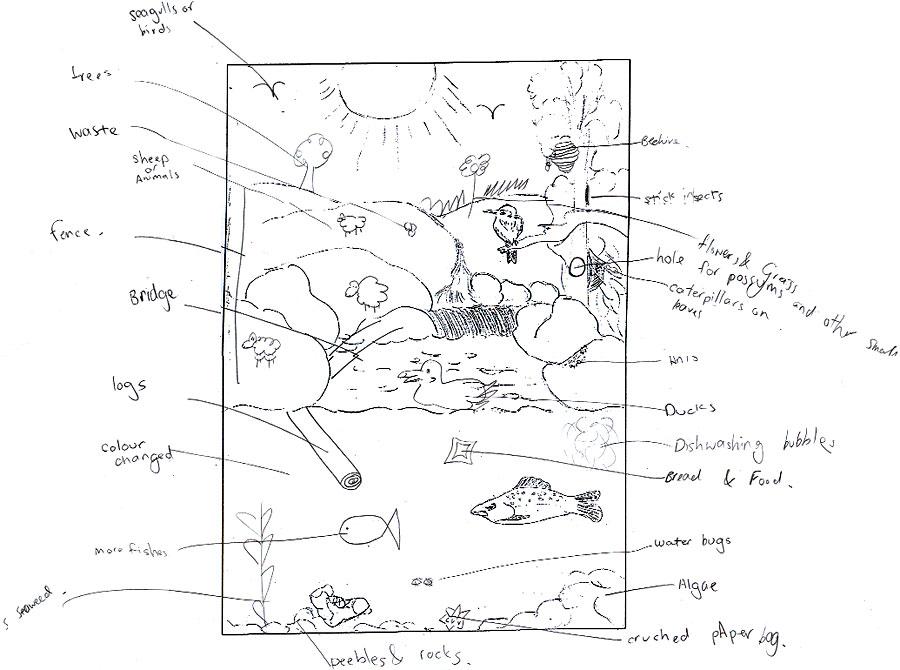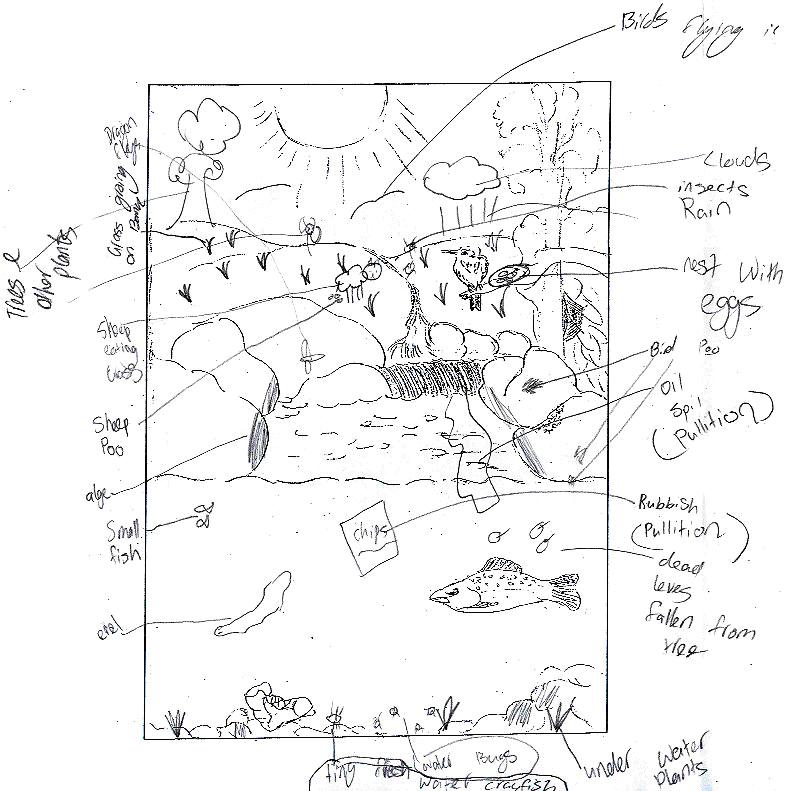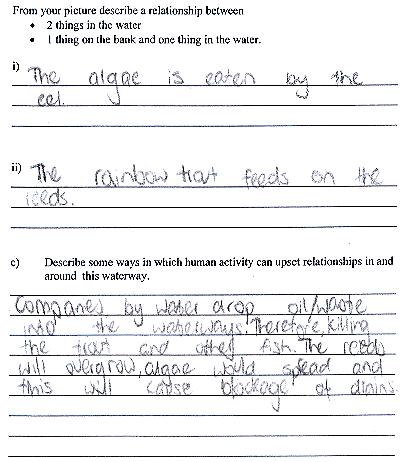What lives in our waterways?
| a) |
Check for the following points.
|
|
| b) |
i) ii) |
Check that the relationship described is correct. (Go to Stream feeding relationships for examples of feeding relationships.) Check that the relationship described is correct. (Go to Stream feeding relationships for examples of feeding relationships.) |
| c) |
Check that the relationship about human activity described is correct. (Go to Stream feeding relationships for examples of feeding relationships.)
For more details go to Thinking about systems. |
- This activity was used during a research project on student understandings of interdependence. The researchers used the task twice, as a diagnostic tool to gauge what understandings the students already had, and then again, after some intervention activities. Selected students were also interviewed to discuss their responses. These interviews provided further insight into their understandings. The task has had some minor changes to address issues that arose during trialling.
- To find out more about the research, go to Inter-relationships research.
- For a summary of information from research about areas where students often have alternative views to scientists, go to Common alternative ideas about inter-relationships.
- Using drawings as an assessment strategy provided evidence of learning that was not always apparent in written assessments. Asking students about their drawings provided additional evidence.
- One teacher noted that the annotated examples could have been used to assist assessing her students talking about their class mural.
Examples of student work
Leona
| Elements of the ecosystem | Direct relationships | Multiple relationships |
 |

Leona has:
- identified a number of parts to the ecosystem, both natural and those caused by humans. Most of these are appropriate to the ecosystem, but she has identified more parts in the surroundings than in the water;
- implied that some human actions can be regarded as positive (by identifying that bread is food);
-
implied two relationships, the hole in the tree for possums and other small animals, and the caterpillars on leaves. She has not explicitly identified the dynamics of the relationships.

Leona has:
- mostly identified elements, without explaining relationships;
- identified what some animals eat;
- inferred that humans are sometimes involved in ensuring animals are provided for
| Possible next learning | Possible activities |
| Plants are an essential part of an ecosystem. | (Re)visit a waterway or use some of the waterway resources (Further resources) to increase knowledge of what lives in the water (including plants). |
| Simple food chains, reinforcing the idea that animals are often not reliant on humans for food. |
Investigate simple food chains in waterways. |
| Address a misconception about scale. It is unlikely that a small event, such as spilling some juice in the stream, will have a significant impact, such as changing the colour of the water. | Discuss scale of impacts, and how the waterway systems can cope with small or temporary changes, but big, ongoing, or permanent changes have long-lasting effects. Include naturally occurring events, such as major storms, droughts, landslides, as well as those caused by people, such as pollution, farming, and culverts. |
| Elements of the ecosystem | Direct relationships | Multiple relationships |
 |
 (beginning) (beginning) |

Zoe has:
- identified parts of the ecosystem, including some elements of the weather cycle;
- included some plants and animals that live in the water, and is beginning to name some species of animals (eel, fresh water crayfish).

Zoe has:
- identified elements of the ecosystem;
- identified a number of elements, including those caused by human activity, that impact on the waterway ecosystem;
- identified some simple food relationships;
- attempted to describe a direct relationship.
| Possible next learning | Possible activities |
| Plants are an essential part of an ecosystem. | Investigate specific animals and plants found in different New Zealand waterways to build up knowledge of species. This can also relate to water quality (refer to waterways projects). |
| Any change to the waterway and what lives in and around it will have an effect on everything else there. | Begin to explore chains of events by playing Waterways Tag. |
Etta
| Elements of the ecosystem | Direct relationships | Multiple relationships |
 |
 |
 (beginning) (beginning) |

Etta has:
- identified a number of valid parts of the ecosystem, both natural and those caused by humans;
- demonstrated an awareness of less obvious but important parts of a stream ecosystem (macro invertebrates, algae);
- used generic rather than specific names;
- identified few plants apart from trees.

Etta has:
- identified both simple and more complex direct relationships;
- discussed a more complex relationship that traces a possible chain of events, although the discussion includes a misconception, that one dead fish would significantly pollute the water.
| Possible next learning | Possible activities |
| Plants are an essential part of an ecosystem. | Investigate specific animals and plants found in different New Zealand waterways to build up knowledge of species. This can also relate to water quality (refer to waterways projects). |
| Address a misconception about scale. It is unlikely that a small event, such as a fish dying, will have a significant impact, such as polluting the water. |
Discuss scale of impacts, and how the waterway systems can cope with small or temporary changes, but big, ongoing, or permanent changes have long-lasting effects. Include naturally occurring events, such as major storms, droughts, landslides, as well as those caused by people, such as pollution, farming, and culverts. |
| Address a misconception that dead things always have a negative impact on the ecosystem. (Decaying fish release nutrients back into the system.) | Investigate the role of scavengers and decomposers in releasing nutrients back into the system. |
Matt
| Elements of the ecosystem | Direct relationships | Multiple relationships |
 |
 (but not always correct) (but not always correct) |
 |
Matt has:
- identified specific animals and plants found in and around the waterway, e.g., tree frog, trout, water spider, kingfisher, reeds;
- included more animals than plants;
- named some of the smaller, less visible parts e.g., algae, leeches;
- indicated some technological elements that impact on parts of the ecosystem, e.g., the factory, although he has not clearly shown how;
- possibly inferred some less well-known feeding relationships, e.g., the leeches present near the legs.

Matt has:
- identified some parts present;
- incorrectly identified feeding relationships (both trout and eels actually eat other animals);
- identified multiple and complex changes to the waterway, including a chain of events, resulting from one human action;
- demonstrated that he understands the impacts on plants (and therefore the ecosystem) when animals that feed on them are removed. However, he has not indicated that the oil could also have a direct negative effect on the plants.
| Possible next learning | Possible activities |
| Plants are an essential part of an ecosystem. | Investigate specific animals and plants found in different New Zealand waterways to build up knowledge of species. This can also relate to water quality (refer to waterways projects). |
|
Different plants need different conditions to flourish. |
Revise the basic needs of all plants. |
| Address misconceptions about food relationships. |
Investigate food chains in waterways. |
General trends
All four students (and most students in the trial):
- named more animals than plants;
- named more animals and plants that lived near the waterway than in it;
- were more inclined to use generic terms (such as fish and insects) than name specific species;
- named more impacts caused by humans than natural events. (The questions asked are likely to have influenced this, as well as the waterways programme completed by the students, which does have a focus on this aspect.)
The following resources were developed as part of a classroom research project about students' progressions in thinking about interdependence.
- Waterways tag - a game that models feeding relationships and how these impact on the population in a waterway
- Waterways relationships web game - a concept mapping activity using cards.
- Interdependence loopy. Interda card game that assesses knowledge of relationships and relevant scientific vocabulary.
Inter-relationships research
The following print resources explore interdependence in a different context.
- Ministry of Education (2002). Building Science Concepts Book 21, Life between the tides. Wellington: Learning Media
- Ministry of Education (2002). Building Science Concepts Book 22, Tidal communities. Wellington: Learning Media.
- Ministry of Education (2001). Making better sense of the living world. Wellington: Learning Media.
Topics are: Earthworms
Mosses and ferns
Aquarium and pond life
Microbiology
- Ministry of Education (2006). Connected 3. The Secret Life of Estuaries. Wellington: Learning Media. This article explores food web ideas with a particular emphasis on the role of organisms that break down detritus. (rotting plant and animal matter).
- National Waterways Project website http://nwp.rsnz.org/content/index.htm
- Regional councils supply resources, including people resources that are relevant to local areas. Many of them provide online resources. For an overview go to the National Waterways website http://nwp.rsnz.org/content/educational_websites.htm
- Up the Creek is an interactive online activity supported by teachers' notes. http://www.learningmedia.co.nz/nz/online/activities


